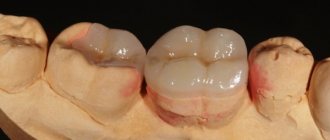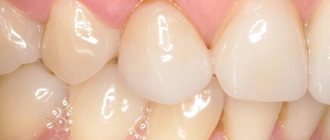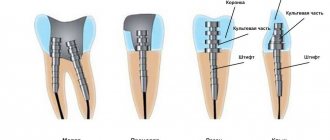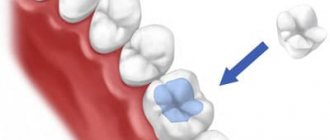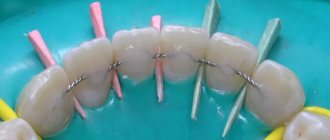From this article you will learn:
- what are dental inlays and what are they?
- their advantages compared to tooth filling,
- dental inlays – cost for 2021.
A dental inlay is a microprosthesis of a tooth that restores its missing part. There are several types of inlays in dentistry, each of which solves separate problems. To restore human teeth, the crown of which is only partially destroyed by caries, a so-called restorative inlay is used. Such a tooth inlay can most often be made of either metal or highly aesthetic metal-free ceramics, and it is an alternative to traditional tooth filling.
The second option is the so-called stump inlays, which are used to restore almost completely destroyed teeth. This inlay consists of two parts - 1) the lower part resembles a pin, which will subsequently be fixed in the root canal with cement, 2) the upper part looks like a tooth stump ground for a crown. After fixing such a tab in the root canal, an artificial crown is fixed on top of it.
Restorative dental inlays: photo
In our article we will talk specifically about recovery tabs. The main difference between such inlays and artificial crowns is that they do not cover the entire tooth, but only 1-2 of its surfaces (Fig. 1-2). Most often, inlays are made for lateral chewing teeth, restoring completely or partially destroyed chewing surfaces. The production of inlays occurs mainly from pressed ceramics and metal alloys, and most often they are classified according to the material of manufacture.
What is a dental inlay?
At its core, a dental inlay is a large filling. Only it is not made by a dentist in the patient’s mouth, but in a dental laboratory using individual impressions. Due to this, the design more accurately follows the shape of the cavity and fits more tightly to the tooth tissue, which minimizes the risk of caries at the junction between the inlay and the tooth.
Inlays, which are used instead of fillings, are often confused with dental cores. These are completely different designs. Let's start with the fact that a dental inlay, instead of a filling, is a restoration element of the crown part of the tooth, and a stump inlay is technical, since it serves as a support for an artificial crown when the tooth is destroyed by more than 2/3. To make it easier for patients to remember the difference, I would differentiate these prostheses as follows: the dental inlay is located outside the living tooth, and the stump inlay is located under the crown.
Cost of dental restoration
The price of a composite inlay for tooth restoration is relatively low.
On average, the cost of one restoration is 6,000 rubles. But the price of turnkey treatment can be 2-3 times higher, especially if it is necessary to first eliminate caries or stomatitis or treat root canals. If you need to put a crown on the stump tab, then, accordingly, the cost will increase (by how much - depends on the material for the crown). 1Makeeva I.M., Nikolaev A.I. Restoration of teeth using light-curing composite materials, 2001.
Inlays and veneers - what's the difference?
Both inlays and veneers belong to microprosthetic technology and are used to restore damaged teeth. However, there are fundamental differences between them.
| Tabs | Veneers |
| Used to reconstruct any side of the tooth surface | Used to restore the outer wall of the dentition |
| Installed on chewing teeth | Fixed in the smile area |
| Recreates the natural shape and functionality of teeth | Intended for aesthetic restoration only |
| Made from gold, metal alloys, zirconium oxide for increased product strength | Created from ceramics, zirconium oxide and composite materials for an absolute appearance identical to natural teeth |
If you are unsure which design is suitable for your case, consult your dentist. He will conduct an examination and help you choose the most suitable option.
Talking to an orthopedic dentist
When a tooth is severely damaged, it cannot be restored using the usual filling method. Too much filling material shrinks - as a result, a microcrack is formed between the filling and the tooth, into which infection seeps. Over time, the tooth develops repeated caries. Therefore, to restore severely damaged teeth, doctors use other options, in particular, inlays.
Together with orthopedic dentist Roman Borisovich Alekperov, we will understand what inlays are, what they are like and how they are installed.
Roman Borisovich Alekperov, orthopedic dentist, first category doctor at the RUTT clinic
Roman Borisovich Alekperov, orthopedic dentist, first category doctor at the RUTT clinic
What are the advantages of dental inlays?
In addition to the manufacturing technology, dentures in the form of inlays differ from fillings in the following parameters:
- Firstly, they are much stronger and more durable than fillings. For example, the service life of a ceramic inlay is 20 - 25 years. Not a single filling is capable of performing its functions efficiently for such a long period. It wears out faster and needs to be replaced. If this is not done, due to a violation of its anatomical shape, the bite begins to be fixed differently, the tooth no longer chews food so effectively, the patient has to make additional efforts, which negatively affects the jaw joints, provoking their diseases.
- Secondly, dental prosthetics with ceramic inlays reliably protects the tooth from further destruction, since ceramics is a durable material that can withstand any chewing and temperature loads. This is the only option for tooth restoration that helps to avoid subsequent pulp removal and crown covering.
Service life
The service life of each type of orthopedic inlay is primarily determined by the material used in their manufacture.
The strongest and most durable of them are gold products. With proper installation and careful handling, the average service life is 8-10 years.
Ceramic structures also have good performance in this regard. The service life is slightly lower than gold, about 6 years.
The following can affect the duration of operation, or rather reduce it:
- unprofessional actions of a specialist during the creation and installation of tabs;
- changes in the structure of bone tissue;
- ignoring or insufficient compliance by the patient with recommendations regarding care, daily hygiene and operation of structures.
Watch the video to see the process of installing the Onlay tab.
What are the pros and cons of different types of tabs?
Many patients are interested in what dental inlays are made of. Based on the material they are made of, they are divided into metal (an alloy of cobalt and chromium), ceramic, zirconium and composite. In this regard, the pros and cons of dental inlays in dentistry are different. The doctor, together with the patient, decides on the choice of design from one material or another, guided by the characteristics of each clinical case separately.
Ceramic
The best ones are E-max ceramic dental inlays, which consist of almost the same advantages. They are the most aesthetic and reliable. Their wear rate is the same as that of natural teeth. In addition, ceramic inlays have the tightest fit to the living tissues of the tooth, thus minimizing the risk of developing secondary caries. But they still have one drawback. This is quite a high price. Zirconium inlays are also a worthy choice; they are very durable, but their adhesion to tooth tissue is worse than ceramic ones.
Composite
Composite inlays made from conventional filling material are not as strong as metal, ceramic or zirconium, but they do not have the following disadvantages that are inherent in fillings made directly in the patient’s mouth.
- The composite dental inlay does not sag. If you put a large filling instead, it will not withstand the load and will tear away from living tissue, creating tension on the walls of the tooth and causing its destruction or injury. This is absolutely not typical for a composite dental inlay.
- Composite inlays do not cause problems with bite and chewing functions. They are made from individual impressions, taking into account the antagonists, that is, the adjacent teeth with which the tooth being restored comes into contact.
Metal
In our clinic, metal dental inlays are used only as a temporary option, since they often cause galvanism in patients, that is, a reaction to the influence of galvanic currents occurring in the oral cavity. This phenomenon is accompanied by a metallic taste in the mouth, a burning sensation, and increased salivation. In addition, the disadvantages of metal inlays include their poor adhesion to tooth tissues, and, as a result, their loss. Among the advantages of these restorations, one can only note their strength and hypoallergenic material. It should be noted that before the advent of ceramics, similar designs made of gold were popular - a soft metal that provided a tighter fit.
Composite inlays have a special advantage that, unfortunately, is missing from other types - they can be repaired in the oral cavity using composite filling materials, and they will continue to successfully fulfill their purpose. Therefore, composite inlays are also installed in cases where, after endodontic treatment of the tooth canals, there is no confidence that they will not have to be re-treated again. If necessary, you can always open them and carry out all the necessary manipulations. Other types of inlays cannot be repaired because the materials from which they are made do not have adhesion to the composite.
Prices
The average cost of a tab is determined by the material from which it is made.
Analyzing the pricing policy of many dental clinics that provide services for the restoration of hard dental tissues with microprostheses, the cost looks something like this:
| Material | Average cost in thousand rubles. (for 1 piece) |
| metal | From 8 |
| plastic | From 6.5 |
| ceramic | From 17 |
| combined | From 12 |
How is a dental inlay installed?
Basically, such prostheses are installed on living teeth, since if the tooth’s nerve is removed, or there is such a need, it means that the tooth is severely damaged and to restore it, it is no longer necessary to have an inlay, but a crown. The installation of a dental inlay occurs in four stages:
- Diagnostics
. First, it is necessary to examine the patient and carry out appropriate diagnostic procedures - take X-rays and computed tomography to obtain a more objective picture of the clinical case. However, it is possible to identify the need to install an inlay and adequately assess the degree of tooth destruction only after preparing the cavity.
- Preparation
. Many patients believe that a dental inlay will require more serious tooth preparation with the removal of a large amount of its tissue. This is not true. The tooth is ground down exactly as much as necessary depending on its destruction. You should not think that the doctor will specifically “bring” the cavity to the size at which the installation of a dental inlay is indicated. In our clinic, we always use the most gentle techniques and try to preserve living tooth tissue as much as possible.
- Manufacturing
. Typically, the time it takes for structures to be ready depends on the workload of the dental laboratory, but, as a rule, the manufacturing process takes about 7 days for any type of inlay.
- Fixation
. Before installing the inlay, the tooth cavity is sandblasted to create an adhesive surface. Next, the microprosthesis is fixed in the cavity with composite cement, and the exit points of the fixing material are ground. After this, occlusal contacts are checked using articulation paper to create multi-point contact of the prosthesis with antagonist teeth.
Reviews
Restoration of damaged teeth with inlays is classified by dentists as the most gentle treatment method. Despite the high cost, its effectiveness is high if there are indications for it.
If you have experience with such treatment and would like to express your opinion on its effectiveness and feasibility, please share your feedback in the comments to this article.
If you find an error, please select a piece of text and press Ctrl+Enter.
Tags tab fixed dentures
Did you like the article? stay tuned
No comments yet
What are the features of making dental inlays?
The inlay is made in dental laboratories using impressions of the patient’s teeth and jaws so that it matches the shape of the dental cavity as accurately as possible and ensures correct contact with other teeth without disturbing the bite. Depending on the material of the structure, a certain technology is used for its manufacture.
If we are talking about ceramic inlays, then first a porcelain frame is made by pressing, and then ceramic mass is applied to it in layers. Metal inlays are cast, and zirconium inlays are produced by digital modeling and milling using an innovative CAD/CAM system. Composite microprostheses are made from a plaster model of the tooth and are polymerized using light or heat.
Photos before and after installing a dental inlay
Caring for restored teeth
To ensure that the restorations retain their shape, color and are firmly held in the cavity for a long time, follow a few simple recommendations:
- brush your teeth 2 times a day with a brush and toothpaste without abrasive particles that can leave scratches on the composite,
- rinse your mouth with clean water after eating or drinking coffee/tea: to prevent the restorations from becoming stained,
- Avoid consuming hot and cold foods at the same time: due to temperature changes, the composite may crack,
- Avoid very hard foods and using your teeth for other purposes (opening lids, biting pencils, etc.): cracks may appear on the tabs,
- For preventative purposes, visit your dentist twice a year.
What are the quality parameters of dental prosthetics with inlays?
If the technology was violated during the process of fixing the inlay, or the patient has not undergone preventive examinations for years, then secondary caries may occur at the border of the contact of the microprosthesis with the dental tissues. Then it will be necessary to carry out treatment and remove the dental inlay. At the same time, the design itself does not in any way stimulate the occurrence of caries. To avoid it, the main thing is to prevent technological inaccuracies during the installation process, so that the tightness of the dental inlay with filling the cavity with composite cement is equal to 0.004 microns. It is also important to ensure that there are no overhanging edges for a complete aesthetic and functional restoration of the tooth.
If the tab is installed correctly, then it does not provoke an increase in tooth sensitivity, and if not, then the antagonist tooth may begin to react to irritants due to malocclusion.
If pain occurs as a result of complications such as caries, pulpitis or periodontitis, the dental inlay must be opened and appropriate treatment carried out. After which this microprosthesis will need to be replaced with a new one.
Flaws
The primary disadvantage of microprostheses is the impossibility of repairing them. If the material is partially destroyed or chipped, the tab must be replaced with a new one.
In addition, the design disadvantages include the following characteristics:
- high cost of installation (compared to conventional filling);
- other specialists are additionally involved in the process, for example, a technician;
- It takes more time to complete the entire complex of recovery manipulations.
It is also necessary to consider the professional factor - incorrect work of the doctor increases the likelihood of complications such as inflammation, tissue infection, poor adhesion of the inlay to the tissues.
